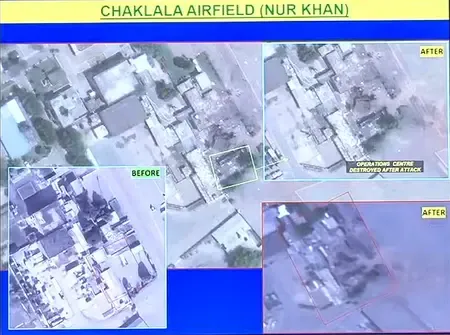Did Satellite Images Uncover More Damage at Pakistan's Nur Khan Airbase than Previously Thought?

Synopsis
Key Takeaways
- Nur Khan airbase suffered more damage than previously reported.
- Recent assessments indicate a larger footprint of destruction.
- The airbase is vital for Pakistan's military operations.
- The strike raises questions about Pakistan's air defenses.
- Operation Sindoor was a significant military engagement.
New Delhi, May 25 (NationPress) Recent satellite imagery indicates that Pakistan's strategically significant Nur Khan airbase has experienced more extensive damage during India's 'Operation Sindoor' than previously estimated.
Nur Khan, a crucial hub for Pakistan's drone and VIP air fleet, is situated in Rawalpindi, less than 25 kilometers from Islamabad. The base is a high-value target, housing essential assets of the Pakistan Air Force.
“An analysis of the Nur Khan Airbase, Pakistan, shows that the entire complex near the strike location has been demolished, indicating that the strike's impact extended beyond the two specialized trucks—suggesting a more significant footprint of the damage,” defense analyst Damien Symon posted on X.
A recent evaluation reveals that a large complex near the strike site has been destroyed, amplifying the perceived impact of the Indian Air Force's precision strikes.
According to The Intel Lab, which disclosed the latest satellite imagery, the destruction appears to surpass the previously reported damage to two specialized trucks. Prior reports based on satellite analysis indicated that India executed precision strikes between May 8 and 10, targeting infrastructure and ground support systems at the Rawalpindi-based airbase. This attack was seen as both strategic and symbolic, as the base lies close to the Pakistan Army's headquarters and serves as the command center for air mobility operations. These operations include Saab Erieye airborne early warning systems, C-130 transport aircraft, and IL-78 mid-air refueling planes, which are vital for logistics, surveillance, and operational coordination.
The base also accommodates Turkish-made Bayraktar TB2 drones and Pakistan’s indigenous Shahpar-I drones, utilized for targeting and surveillance missions.
Nur Khan is pivotal to Pakistan's drone warfare strategy and hosts the nation's elite pilot training and VIP fleet, including the presidential aircraft. The extent of the strike has unveiled considerable vulnerabilities in Pakistan's air defense system.
Adding to the narrative, Pakistan Prime Minister Shehbaz Sharif disclosed that he was awakened in the early hours of May 11 by army chief General Syed Asim Munir, who informed him that Indian ballistic missiles had struck multiple airbases, including Nur Khan.
Sharif recently stated during a public meeting that he received a call from General Munir at 2:30 a.m. on a secure line. He informed him that India had just launched ballistic missiles, and one had struck Nur Khan Airport. He was speaking on Youm-e-Tashakur (Day of Thanks).
According to Sharif, Pakistan retaliated by targeting Indian locations, including Pathankot and Udhampur. This escalation followed the April 22 terror attack in Pahalgam, Jammu and Kashmir, which resulted in 26 fatalities.
India launched Operation Sindoor on May 7, targeting terror infrastructure in Pakistan. In response, Pakistan initiated missile attacks on May 8, 9, and 10.
On May 10, Pakistan military spokesperson Lt Gen Ahmad Sharif Chaudhry confirmed in a 4 a.m. press briefing that India had targeted Nur Khan (Rawalpindi), Murid (Chakwal), and Rafiqui (Jhang) airbases. His statement validates that Nur Khan was one of the closest Indian strike points to Islamabad. By the evening of May 10, both sides announced that they had agreed to de-escalate the confrontation after four days of intense military engagement across the border.









